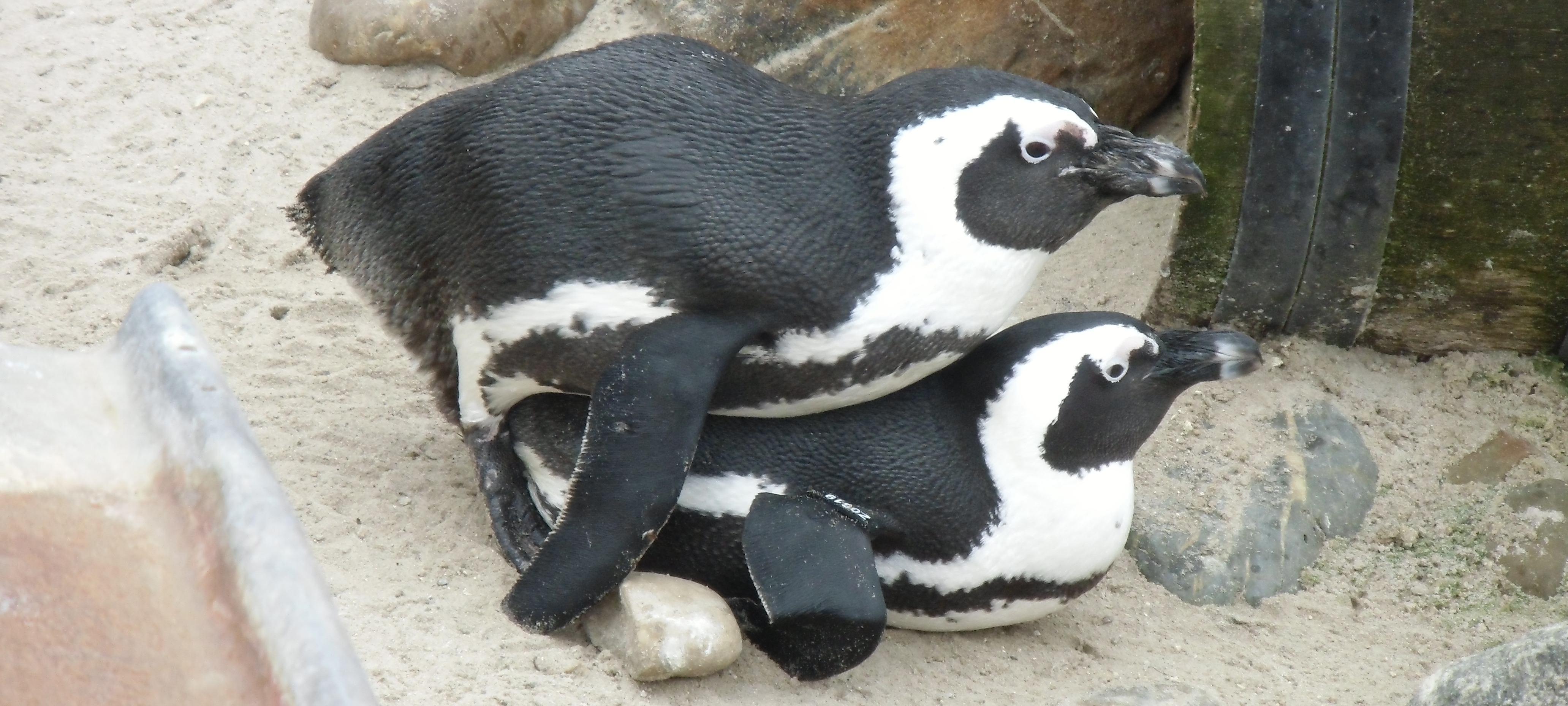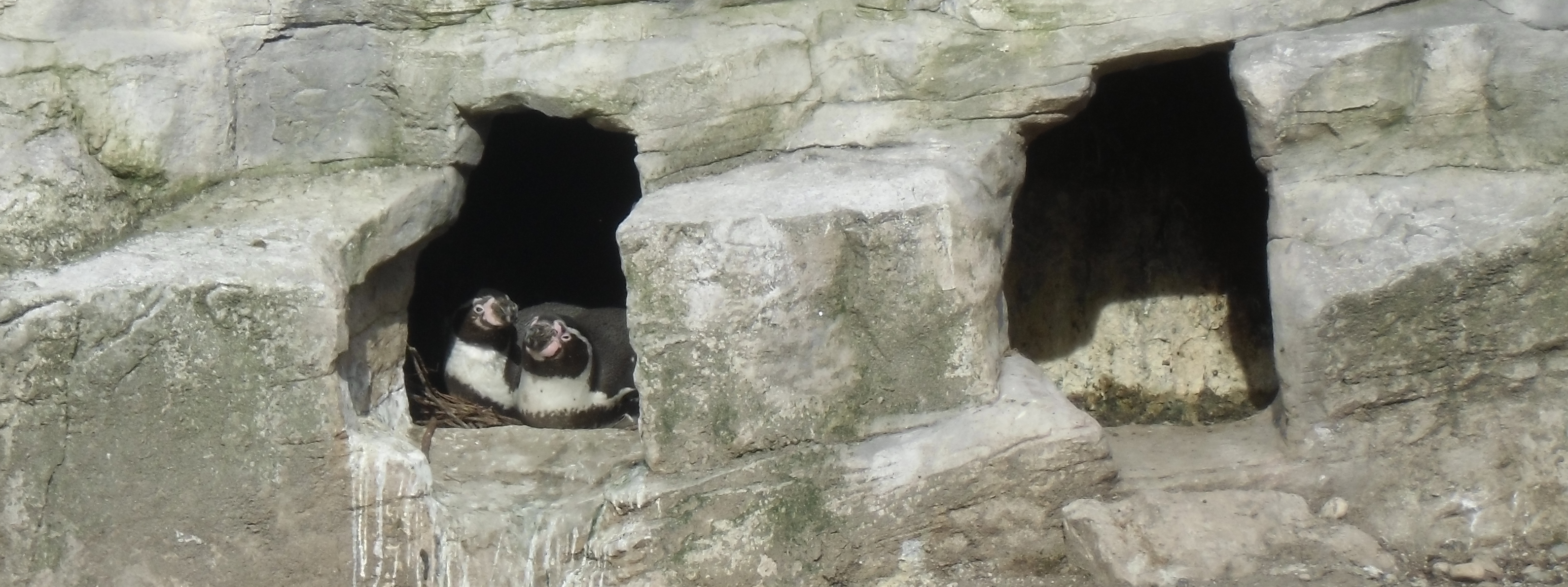
PinguinWissen.de – English
Reproduction
- • Penguins are monogamous. One breeding pair consists of two penguins.
- • Penguins are faithful animals. However, a pair might be separated one day.
- • During copulation the male sits on the female and both cloacae are pressed on each other. Male penguins have no penis.
- • The number of eggs, nest-building and duration of chick rearing is different between the penguin species.
Partner selection
The partner selection begins with a display. In general, the male shows specific postures while making typical noises and presenting his nest. If a female appeals to his actions, she will answer with gestures (e. g. head shaking or bowing). After that both partners can show their affection by dancing and singing a while. This courtship behaviour varies from species to species.
Fidelity in penguins
Penguins are monogamous birds. Every year the male waits for his "wife" at nest side. If they get together, they will rear up a chick again. However, it could happen that one partner died at sea. In this case, the survived partner selects another partner. But if the former partner appears eventually, the new partner will be expulsed.
Copulation

Arms act in African Penguins, Zoo Münster in Germany
The copulation begins with the "arms act" frequently. This behavioral pattern was described by Richdale in the Yellow-eyed Penguin. But other penguin species show this behaviour, too. For example, it was observed in Chinstrap, Gentoo or Adelie penguins. I myself witnessed it in Jackass Penguins (see picture left).
The male stands behind the female densely and pushes his throat at her neck. Thereby his flippers vibrate at her side. After this act, the copulation could follow. The male pushes the female with his bill from behind, so she lies down on the ground. Then the male climbs on her back, his flippers are still vibrating. If he stands on top of the female, he presses his cloaca against her cloaca. After this act the male leaves the back of the female.
The copulation is a very difficult process because the male has to balance on the female's rounded body. Therefore, this act is repeated a couple of times.

African Penguins in Hanover Zoo, Germany
Video 1: Copulation, front view
In this video you can see that copulation in penguins is very shaky. The male has to adjust the position of his feet on the back of the female permanently to keep his balance. He vibrates his flippers to get additional lateral stability. During the copulation the male sometimes keeps standing on the female and stops moving. In this situation it seems very easy for the male to keep the balance. So, why the sexual act is so difficult and shaky? The following video will show more details of the copulation from back view.
African Penguins in Hanover Zoo, Germany
Video 2: Copulation, back view:
The female puts her tail up straightly so that the male can reach her cloaca (light pink spot underneath the tail) better. In this video you can see why the copulation is so difficult: the male has to move his cloaca sideways to the tail of the female to press it on the female's. During this movement the balance point of the male is shifted to one side. That is why the male often has to put his foot on the ground to keep on the back of the female or to adjust his position again.
Furthermore, you can see that the male sways his tail fastly when it is near the tail of the female. Supposedly, in this way it is easier to find the cloaca of the female. When both cloacas are pressed together the male ejaculates. After that the male leaves the back of the female.
African Penguins in Hanover Zoo, Germany
Nest-building

Humboldt Penguins nesting in Tierpark Hellabrunn, Munich, Germany
The method in nest-building differs from species to species.
• Jackass, Magellanic, Galapagos and Little Blue Penguins nest in crevices or holes in the ground to protect their clutch or chicks against the sun.
• Chinstrap, Adelie and Gentoo Penguins build their nests with little stones because there is no other material in Antarctica.
• That is why Emperor and King Penguins pass on nest-building and lie their egg on their feet.
Eggs
Egg deposition takes place a few days after the last copulation act. Commonly, penguins lay two eggs. Banded Penguins can have up to three eggs while Great Penguins always lay one egg.
Chick rearing

Adult African Penguin with chick at Boulders Beach, South Africa
After the female lays the egg(s), she gives them to her partner and then she goes to the sea in order to feed. Dependent on the species and their habitats, the female comes back between one day (if the breeding colony is near the coast) and up to 60 days (Emperor Penguin). Then she takes care of the nest with the eggs and supports them. In the meantime, the male goes feeding. These jobs are shared by the partners during egg stage and chick rearing.
The chicks hatch after 32-68 days (dependent on the species). Then their parents feed them by regurgitating fish, crabs or calmaries in little portions so that their chicks can grow.
Penguins rear their chicks between october and march, then it is summer on the southern hemisphere. However, King and Emperor Penguins need more time for chick rearing than the other species. That is why, Emperor Penguins already begin breeding in antarctic winter.
References
Was ist Was Band 107 "Pinguine" and "Pinguine - Alles über die sympathischen Vögel aus dem Eis", both by Boris Culik (German books)
Penguins - Natural History and Conservation, edited by P. G. Borboroglu and P. D. Boersma, 2013
Seddon, P. 1989. Copulation in the Yellow-eyed Penguin. Notornis 36: 50-51
Richdale, L. E. 1951. Sexual behavior in Penguins. University of Kansas Press
↑ back to top ↑
PinguinWissen.de
Further information
Last update: 19.01.2021
Currently under construction: Design and texts.
 GER
GER